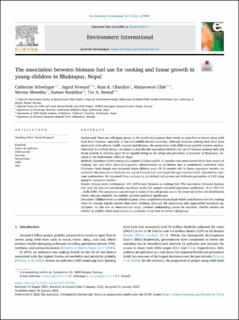| dc.contributor.author | Schwinger, Catherine | |
| dc.contributor.author | Kvestad, Ingrid | |
| dc.contributor.author | Chandyo, Ram Krishna | |
| dc.contributor.author | Chandyo, Manjeswori Ulak | |
| dc.contributor.author | Shrestha, Merina | |
| dc.contributor.author | Ranjitkar, Suman | |
| dc.contributor.author | Strand, Tor Arne | |
| dc.date.accessioned | 2022-11-21T12:26:39Z | |
| dc.date.available | 2022-11-21T12:26:39Z | |
| dc.date.created | 2022-02-23T07:46:08Z | |
| dc.date.issued | 2022 | |
| dc.identifier.issn | 0160-4120 | |
| dc.identifier.uri | https://hdl.handle.net/11250/3033142 | |
| dc.description.abstract | Background There are still many people in the world who prepare their meals on open fires or stoves using solid fuels from biomass, especially in low-and middle-income countries. Although biomass cooking fuels have been associated with adverse health impacts and diseases, the association with child linear growth remains unclear. Objectives In a cohort design, we aimed to describe the association between the use of biomass cooking fuels and linear growth in children aged 18–23 months living in the urban and peri-urban community of Bhaktapur, situated in the Kathmandu valley in Nepal. Methods Caretakers of 600 marginally stunted children aged 6–11 months were interviewed about their source of cooking fuel and other socio-demographic characteristics at enrolment into a randomized controlled trial. Children’s body length was measured when children were 18–23 months old. In linear regression models, we estimated the association between the use of biomass fuel and length-for-age Z-scores (LAZ), adjusted for relevant confounders. We repeated these analyses in pre-defined sub-groups and different percentiles of LAZ using quantile regression models. Results Among study participants, 101 (18%) used biomass as cooking fuel. The association between biomass fuel and LAZ was not statistically significant in the full sample (adjusted regression coefficient: –0.14, 95% CI: −0.28, 0.00). The association was stronger in some of the sub-groups and in the lower tail of the LAZ distribution (those who are stunted), but neither reached statistical significance. Discussion Children from households in poor, urban neighborhoods in Nepal which used biomass fuel for cooking were on average slightly shorter than other children, although the association only approached statistical significance. As this was an observational study, residual confounding cannot be excluded. Further studies are needed to confirm these associations, in particular those seen in certain sub-groups. | en_US |
| dc.language.iso | eng | en_US |
| dc.publisher | PLOS | en_US |
| dc.rights | Navngivelse 4.0 Internasjonal | * |
| dc.rights.uri | http://creativecommons.org/licenses/by/4.0/deed.no | * |
| dc.title | The association between biomass fuel use for cooking and linear growth in young children in Bhaktapur, Nepal | en_US |
| dc.type | Journal article | en_US |
| dc.type | Peer reviewed | en_US |
| dc.description.version | publishedVersion | en_US |
| dc.rights.holder | Copyright 2022 The Author(s) | en_US |
| dc.source.articlenumber | 107089 | en_US |
| cristin.ispublished | true | |
| cristin.fulltext | original | |
| cristin.qualitycode | 1 | |
| dc.identifier.doi | 10.1016/j.envint.2022.107089 | |
| dc.identifier.cristin | 2004712 | |
| dc.source.journal | Environment International | en_US |
| dc.relation.project | Norges forskningsråd: 223269 | en_US |
| dc.subject.nsi | VDP::Medisinske fag: 700 | en_US |
| dc.subject.nsi | VDP::Midical sciences: 700 | en_US |
| dc.identifier.citation | Environment International. 2022, 161, 107089. | en_US |
| dc.source.volume | 161 | en_US |

